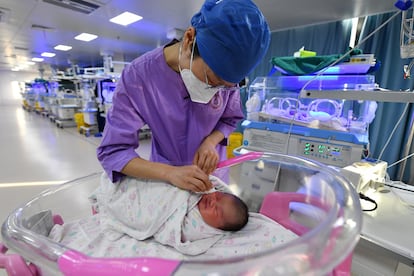Russia’s population shrinks and China’s ages
Shifting demographics are posing unprecedented challenges for China and Russia

Can a military superpower maintain its global dominance even if its population is shrinking? What about when its population is aging and will soon be dominated by the elderly? These are not hypothetical questions; they are happening right now. Russia is depopulating and China is aging rapidly. And these are not the only demographic woes that are weakening these two nuclear powers.
Between 1994 and 2021 the Russian population decreased by six million (from 149 to 143 million people). According to the U.N., if Russia follows the current demographic trend, its population will fall to 120 million by 2050.
China is also shrinking. In 2022 — for the first time since 1961 — it had a net loss of citizens. But that’s not all. On top of this, China’s population is, on average, getting older, forcing a smaller and smaller percentage of the population to work to support the growing proportion of retirees.
These aging and shrinking trends in China and Russia will pose unprecedented challenges. Demographic decline not only threatens the stability of these military superpowers, but also brings labor shortages and amplifies disruptions to the job market. The decrease in the workforce simultaneously reduces the income that the government receives from taxes, which in turn reduces its ability to finance pensions and essential social services.
In this sense, demography can be just as destabilizing as any external shock. Similarly, a rapid increase in the population can be just as destabilizing as a sudden decline.
The Economist recently warned that “a demographic tragedy is unfolding in Russia. Over the past three years the country has lost around two million more people than it would ordinarily have done, as a result of war, disease and exodus. The life expectancy of Russian males aged 15 fell by almost five years, to the same level as in Haiti.”
Naturally, the demographic situation in Russia, which was already bad, has been made worse by the war in Ukraine. According to U.S. and European security agencies, between 175,000 and 250,000 Russian soldiers were killed or wounded in 2022. And between 500,000 and one million Russians (many young and well-educated) sought exile abroad. Thus, war and the flight of human capital have added to Russia’s chronic problems such as aging, low birth and fertility rates, high infant mortality, a weak healthcare system, and lethal levels of addiction to tobacco, alcohol, and drugs. What’s more, mortality rates worsened between 2020 and 2023 due to the Covid pandemic, which, according to The Economist, claimed the lives of between 1.2 and 1.6 million Russians.
Even setting aside the pandemic, China has been facing a sustained population decline. In 2022, there were half as many births as six years earlier. This is due, in part, to the “success” of the one-child policy that the Beijing government imposed in 1980 to limit population growth. In 2016, the government abandoned this policy, since by then Chinese leaders had realized that their problem was no longer rising birth rates but falling ones. The impacts are already apparent. In fact, the working-age population has been declining for the last eight years, which is raising concerns about China’s anemic economy. In 2022, China’s economy grew at its slowest rate since 1976.
The Beijing government currently sees population growth and population renewal as important means of stimulating the economy. To promote these goals, it has created all kinds of incentives to incentivize births, including cash payments, tax breaks, and long periods of paid maternity — and paternity — leave.
Unfortunately, experience shows that attempts to boost the birth rate through government incentives are rarely effective. There are much stronger cultural, social, and economic forces at work that have reduced the Chinese people’s interest in getting married and having children. In 2022, for example, the number of marriages fell to its lowest level since 1985. The birth rate fell too. As the experience of countries such as Sweden, Italy or Australia shows, government subsidies aren’t enough to reverse the trend.
The reasons for getting married and having children certainly include material calculations, but they are also determined by cultural factors and expectations about the future of the country and its ability to provide opportunities for its population.
Optimism about the future matters as much or more as the cash promised to each woman who has a child. And the data on marriages and childbirth show that a growing number of Chinese do not seem to be willing to bet on their country.
Tu suscripción se está usando en otro dispositivo
¿Quieres añadir otro usuario a tu suscripción?
Si continúas leyendo en este dispositivo, no se podrá leer en el otro.
FlechaTu suscripción se está usando en otro dispositivo y solo puedes acceder a EL PAÍS desde un dispositivo a la vez.
Si quieres compartir tu cuenta, cambia tu suscripción a la modalidad Premium, así podrás añadir otro usuario. Cada uno accederá con su propia cuenta de email, lo que os permitirá personalizar vuestra experiencia en EL PAÍS.
¿Tienes una suscripción de empresa? Accede aquí para contratar más cuentas.
En el caso de no saber quién está usando tu cuenta, te recomendamos cambiar tu contraseña aquí.
Si decides continuar compartiendo tu cuenta, este mensaje se mostrará en tu dispositivo y en el de la otra persona que está usando tu cuenta de forma indefinida, afectando a tu experiencia de lectura. Puedes consultar aquí los términos y condiciones de la suscripción digital.
More information
Archived In
Últimas noticias
Most viewed
- Sinaloa Cartel war is taking its toll on Los Chapitos
- Oona Chaplin: ‘I told James Cameron that I was living in a treehouse and starting a permaculture project with a friend’
- Reinhard Genzel, Nobel laureate in physics: ‘One-minute videos will never give you the truth’
- Why the price of coffee has skyrocketed: from Brazilian plantations to specialty coffee houses
- Silver prices are going crazy: This is what’s fueling the rally











































